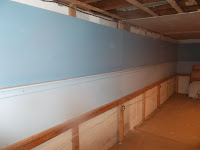Modeling Information
Modelers have used a variety of material to make their backdrops. Those materials include drywall, masonite, linoleum vinyl flooring, aluminum flashing and styrene sheet.
Each material has its own strengths and weaknesses.
Here is a list of web sites that I have relied on in the past and
present when it comes to backdrop construction. Each of them has an
excellent series of construction articles that you will find of
interest.
Southern Pacific Cascade Line Bill uses an open grid frame and 1/8in tempered hardboard.
Building the SP Los Angeles Division Rick uses open grid framework (welded metal) and drywall.
Conrail's Onondaga Cutoff.blogspot.com Dave Abeles uses stud wall framework and masonite sheet.
Adena Railroad Chris Ellis uses stud wall framework and a combination of hardboard and styrene.
Chesapeake, Wheeling and Erie Railroad Tom Patterson uses open grid framework and and flat top (plywood) track support.
Signal Station 199 Joe Smith uses a stud wall framework and masonite sheet.
LK&O Alan uses stud wall framework and masonite sheet.
New Britain Station Randy uses stud wall framework and masonite sheet.
PRR - Northern Central The PRR - Northern Central uses stud wall framework, masonite sheet and then a plastic top sheath..
The CB&Q in Wyoming Mark Pruitt uses open grid framework and styrene sheet.
modeling the CNW in Milwaukee Charles Hostetler uses open grid framework and 1/2-inch foamboard.
Maryland and Pennsylvania Ted DiIorio uses a plywood framework and PVC vinyl flashing.
Elgin Car Shops Pierre Oliver used stud wall framework and styrene sheet.
Gorre and Dephetid Railroad John Allen used stud wall framework and the back of linoleum vinyl flooring.
The Hills Line James McNab uses a open grid framework and aluminum flashing.
Port Rowan in 1:64 Trevor
Marshall employs a simple cloth backdrop of a blue/grey tone.
The product is similar to masonite and it is generally immune to deformation due to water or acrylic paint scenic applications. As the layout is designed for moving, I chose NOT to do any joint filling work except in the corners. Any pictures taken will have to be photoshopped to eliminate the small seams which are visible.
The backdrop at the corners is square. I chose not to curve (or cove) the backdrop.
The peninsula backdrop terminates abruptly. I wasnt sure what to do. Other layouts round off the end with either a half circle the width of the backdrop or flare the backdrop into a teardrop shape. Either of these techniques is designed to prevent the observer from seeing both sides of the backdrop simultaneously.
For simplicity of moves, a rounded end would be difficult to install after the fact, and a nightmare to deconstruct for any move. I decided that I would use other means to divert someone looking directly down the plane of the backdrop.The upper section is mountainous and has a tunnel, so there is no requirement for a rounded backdrop. The bottom section is open and is modeled as a turnback curve. I've opted to terminate the backdrop at this point and plan to use a building (the O. MacDonald Coal Company) to visually block part of the square end of the backdrop.
I have one location (Brady Wa.) that will have a hole cut in the backdrop for passing a train from Brady Junction to Schafer Prairie (the helix). The track is on an angle to the backdrop. A 'tunnel portal' equivalent hole is to be cut to fit the largest passenger car I "could" use. I know, this is quite minimal, but I wanted the hole to be as small as possible to be easier to conceal later.
The backdrop is painted in one of two sky colors. See 5.4.1 Sky for additional details.


No comments:
Post a Comment